
-
Find the right food for your petTake this quiz to see which food may be the best for your furry friend.Find the right food for your petTake this quiz to see which food may be the best for your furry friend.Featured products
 Large Breed Adult Dog Food
Large Breed Adult Dog FoodHill's Science Plan Large Breed Adult Dog Food with Lamb & Rice is a complete pet food, specially formulated with ActivBiome+ Multi-Benefit Technology.
This food is specifically designed to fuel the energy needs of large breed dogs during the prime of their life.Shop Now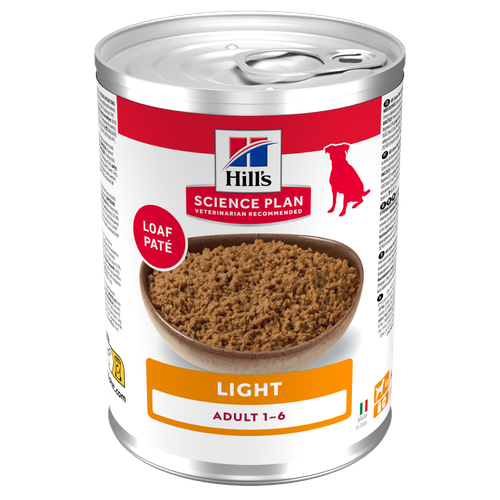 Adult Light Dog Food
Adult Light Dog FoodHill's Science Plan Light Adult Wet Dog Food is a complete premium pet food for adult dogs that tend to gain weight easily. This deliciously smooth loaf is formulated to deliver the appropriate amount of energy to support weight maintenance in adult dogs.
Shop Now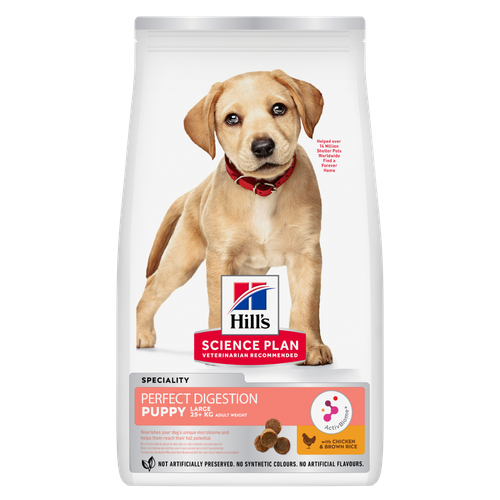 Perfect Digestion Large Breed Puppy Food
Perfect Digestion Large Breed Puppy FoodPrecisely balanced nutrition with Hill's ActivBiome+ prebiotic blend actively contributes to supporting digestive health and overall wellbeing to help your pet feel their best
Shop NowFeatured products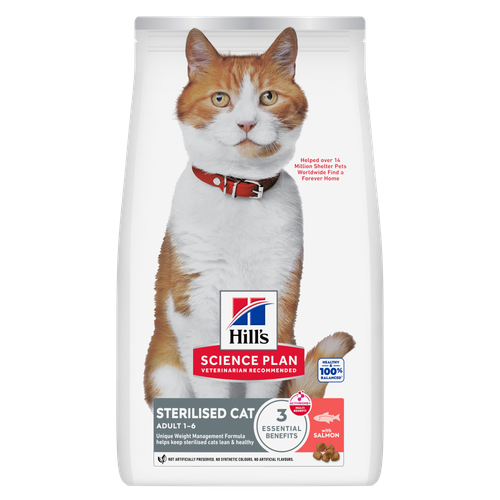 Sterilised Adult Cat Food
Sterilised Adult Cat FoodHill's Science Plan Adult Sterilised Cat Dry Food with Salmon is specially formulated with ActivBiome+ Multi-Benefit Technology. It is a precisely balanced nutrition, tailored to meet the needs of sterilised cats, to help keep sthem lean & healthy.
Shop Now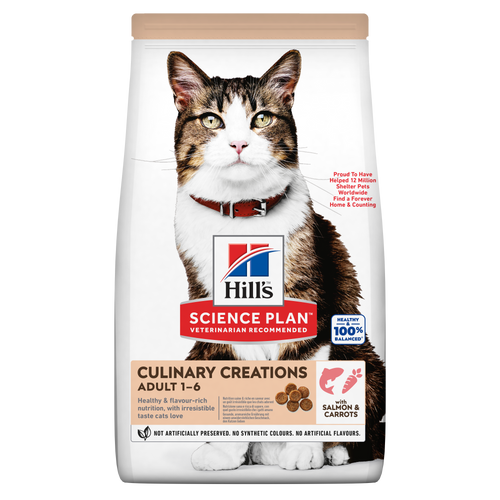 CULINARY CREATIONS ADULT CAT FOOD
CULINARY CREATIONS ADULT CAT FOODHill's Science Plan CULINARY CREATIONS Adult cat food with Salmon & Carrots was formulated to provide a great-tasting experience to cats. Its delicious flavour and texture are combine with essential nutrients to support cats' optimal health during the prime time of their life. Specially formulated with high-quality salmon protein, essential taurine for heart health & balanced minerals to support kidneys & bladder.
Shop Now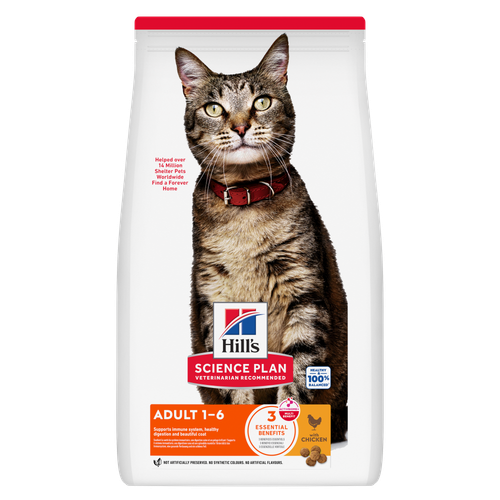 Adult Cat Food
Adult Cat FoodHill's Science Plan Adult Cat Food with Chicken is a complete pet food, specially formulated with ActivBiome+ Multi-Benefit Technology.
This food is specially formulated to fuel the energy needs of cats during the prime of their life.Shop Now -
Dog
- Dog Tips & Articles
-
Health Category
- Weight
- Food & Environmental Sensitivities
- Urinary
- Digestive
- Joint
- Kidney
-
Life Stage
- Puppy Nutrition
- Adult Nutrition
- Senior Nutrition
Cat- Cat Tips & Articles
-
Health Category
- Weight
- Skin & Food Sensitivities
- Urinary
- Digestive
- Kidney
-
Life Stage
- Kitten Nutrition
- Adult Nutrition
Featured articles Pet Nutrition: What Makes "Healthy" Pet Food Healthy? | Hill's Pet
Pet Nutrition: What Makes "Healthy" Pet Food Healthy? | Hill's PetIn people, the right diet is very important. If you are eating the wrong way for your metabolism, activity level, age and lifestyle you could end up with health issues.
Read More Microchipping: The Facts | Hill's Pet
Microchipping: The Facts | Hill's PetThe government has announced that as of April 2016, all dogs in the UK must be microchipped by law.
Read More The Incredible Science Behind Your Pet's Microbiome
The Incredible Science Behind Your Pet's MicrobiomeLearn what your pet's microbiome is, how it contributes to your pet's gut and overall health, and why nutrition is important in maintaining healthy microbiomes.
Read More -


Gingivitis is the most common type of oral disease among cats and it's as prevalent among cats as it is in dogs and humans. However, cat gingivitis may involve more than the simple swelling and bleeding of the gums you might experience in your own mouth. Indeed, in some cases, it can be life-threatening.
Because it's so common — as well as potentially complex and severe — it's important for cat parents to understand the causes and signs of feline gingivitis, as well as basic treatment and prevention measures.
What Is Gingivitis?
Gingivitis is an inflammation of the gums. It mostly occurs in senior cats, when plaque builds up and the gums respond with swelling, redness, bleeding and sensitivity. Plaque is an accumulation of bacteria combined with substances that turn the mix into a concretion that adheres to the teeth. Plaque leads to swelling of both the gums and the periodontal ligament — the structure that attaches teeth to the underlying bone.
When only the gums react, the result is gingivitis, which literally means inflammation of the gums. When the disease progresses and the periodontal ligament reacts to plaque with swelling and deterioration, the resulting disorder is referred to as periodontitis, or periodontal disease. The terms gingivitis and periodontal disease are often incorrectly used interchangeably, so it's important to distinguish them from one another.
Causes of Gingivitis in Cats
In most cats, gingivitis is the result of gradual plaque accumulation, a process that occurs as cats age, if they don’t get appropriate dental care at home. There's tremendous variation in the degree to which cats' gums react to plaque. Some cats seem to accumulate large amounts of plaque with a minimum of gingivitis while other cats' gums react more severely.
A cat's unique degree of gingivitis and periodontitis can be affected to a degree by genetic susceptibility and will also depend on how much dental care they get at home. But gingivitis in cats can also be affected by certain conditions, including:
- Infectious diseases: Feline leukaemia virus and feline immunodeficiency virus are the most common infectious diseases that can lead to gingivitis.
- Tooth resorption: This phenomenon used to be called Feline Odontoclastic Resorptive Lesions (FORL). It’s a common condition in cats where the body starts to resorb the teeth from the roots. It’s very painful and is diagnosed by taking x-rays of the teeth and gums. The only treatment is removal of the affected teeth and, in some cases, this means all the teeth. Although this sounds extreme, cats do very well afterwards and, most importantly, are pain-free. During tooth resorption, gingivitis is common.
- Juvenile-onset gingivitis: Teething cats typically experience mild gingivitis, but severe gingivitis can also occur after adult teeth come in.
- Fractured teeth: Traumatic conditions can trigger gingivitis.
- Malocclusions: Misaligned teeth, seen commonly in flat-faced (also called brachycephalic) cats, and other orthodontic abnormalities may lead to gingivitis.
- Eosinophilic granuloma complex: This inflammatory disease can sometimes affect the lips, gums, tongue and, consequently, nearby teeth.
- Gingival hyperplasia: While less common in cats than dogs, gum overgrowth leads to gingivitis in both species.
- Gingivostomatitis: This disease is the result of an extreme overreaction of the gums and surrounding oral tissues to dental tissues and plaque, and can cause a debilitating amount of pain. Cats with the condition may be unable to eat or drink. Sometimes the pain and inflammation is so severe that a complete extraction of all teeth is the only remedy. This sounds drastic but most cats do really well afterwards and have a vastly improved quality of life.



Tasty Tips
Signs of Feline Gingivitis
As we said, the primary signs of feline gingivitis include redness and bleeding at the gumline. More severely affected cats will have oral pain. You'll be able to tell whether your cat is in pain if they do any of the following:
- Drool
- Show an unwillingness to eat and/or drink
- Sit in front of the food or water bowl
- Eat messily or eat with one side of the mouth
- Cry or yowl when eating
- Lose weight
- Stop grooming themselves or have an unkempt coat
Cats are very good at hiding pain and even cats that are in severe pain and discomfort may not make it obvious to their owners. Conversely, some cats, like humans, have a lower threshold for pain and may be quite the opposite!. A check up with your vet twice a year will help to ensure your cat's mouth and teeth get thoroughly examined.
Treating Feline Gingivitis
Addressing plaque and tartar is the main goal of gingivitis treatment. Routine dental cleaning under anaesthesia can usually take care of this. For more severe cases, veterinarians may recommend one or more of the following measures:
- Antibiotic therapy
- Anti-inflammatory medicine, such as corticosteroids and other immune-modulating drugs
- Dental extraction(s), including full-mouth extractions for cats with severe gingivostomatitis
- Gingivectomy (removal of part of the gums)
Preventing Gingivitis in Cats
Plaque control is by far the most effective means of preventing gingivitis in most cats, with daily teeth brushing being the best method. Water additives, chlorhexidine rinses and plaque-control treats are of lower value but can be somewhat effective.
Contrary to common belief, research has yet to show that cat gingivitis can be prevented simply by feeding a cat dry food. However, specially formulated dental cat foods have been shown to be effective at reducing plaque accumulation and reducing gingivitis. Be sure to ask your veterinarian for foods that are VOHC (Veterinary Oral Health Council) approved. These are foods that have been shown to reduce tartar and plaque in cats. As we said, brushing is the best way to keep teeth healthy, but us humans are not very good at sticking with things long term so many people find these special foods more convenient and effective.
Remember that brushing and special dental foods should not be started without your vet’s sayso. If your cat already has the onset of gum disease then these things could worsen the pain and inflammation. Make sure your vet gives your cat a clean bill of dental health before you start preventative measures. Remember also, the younger your cat is when you start brushing, the easier things will be and you will have greater success. Coupled with routine dental care, regular veterinary visits and daily brushing, most gingivitis cases can be successfully managed.


Dr. Patty Khuly is an award-winning veterinarian known for her independent thinking, her spirited pet advocacy, her passion for the veterinary profession, and her famously irreverent pet health writing.
Dr. K is an honors graduate of both Wellesley College and the University of Pennsylvania School of Veterinary Medicine. She received her MBA at The Wharton School of Business as part of the prestigious VMD/MBA dual-degree program. She now owns Sunset Animal Clinic, a veterinary practice in Miami, Florida.
Related products

Hill's Science Plan CULINARY CREATIONS Adult cat food with Salmon & Carrots was formulated to provide a great-tasting experience to cats. Its delicious flavour and texture are combine with essential nutrients to support cats' optimal health during the prime time of their life. Specially formulated with high-quality salmon protein, essential taurine for heart health & balanced minerals to support kidneys & bladder.
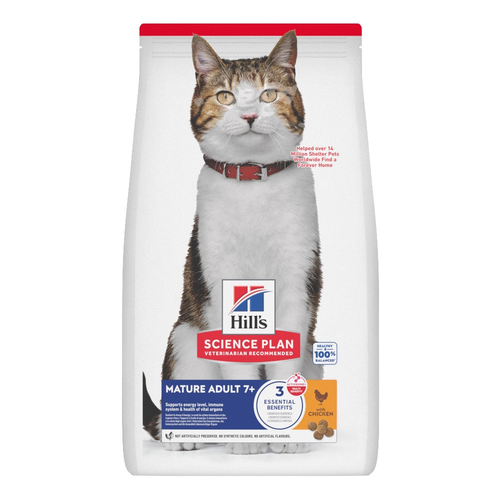
Hill's Science Plan Mature Adult Cat Food with Chicken is a complete pet food, specially formulated with ActivBiome+ Multi-Benefit Technology.
This food supports graceful aging in cats, providing a synergistic ingredient blend to help support energy & activity levels.

Hill's Science Plan Adult Cat Food with Chicken is a complete pet food, specially formulated with ActivBiome+ Multi-Benefit Technology.
This food is specially formulated to fuel the energy needs of cats during the prime of their life.

Hill's Science Plan Adult Sterilised Cat Dry Food with Salmon is specially formulated with ActivBiome+ Multi-Benefit Technology. It is a precisely balanced nutrition, tailored to meet the needs of sterilised cats, to help keep sthem lean & healthy.
Related articles

Learn about the causes of cat dermatitis, how to spot the symptoms and the best treatment options. Visit Hill's Pet for detailed guidance and tips.

Understand common skin issues in cats and how to manage them effectively. Learn signs and prevention, and get care tips. Find out more at Hill's Pet.

Learn how your cat's poo can be a good indicator of her overall health, including how to spot unhealthy or abnormal cat poop and what it might mean.

Cats with sensitive skin have special needs and even healthy cats can sometimes develop poor skin health. Learn more about sensitive skin symptoms in your cat, what you can do to help your pet feel more comfortable and get recommendations on sensitive skin cat food.

Put your cat on a diet without them knowing
Our low calorie formula helps you control your cat's weight. It's packed with high-quality protein for building lean muscles, and made with purposeful ingredients for a flavourful, nutritious meal. Clinically proven antioxidants, Vitamin C+E, help promote a healthy immune system.
Put your cat on a diet without them knowing
Our low calorie formula helps you control your cat's weight. It's packed with high-quality protein for building lean muscles, and made with purposeful ingredients for a flavourful, nutritious meal. Clinically proven antioxidants, Vitamin C+E, help promote a healthy immune system.

